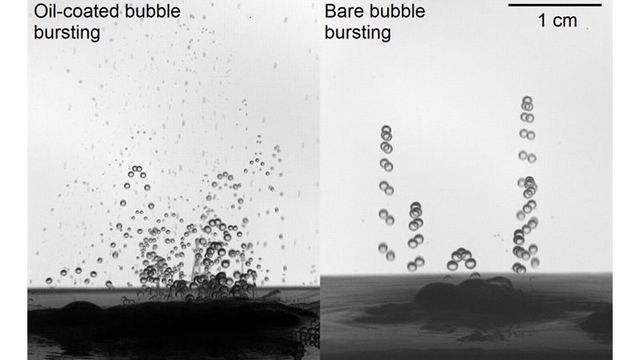Bubble bursting at liquid-air interfaces can cause harm to the environment and public health by spreading contaminants and microbes. Previous research has focused on “clean” bubbles, but new research shows that contaminated interfaces are more prevalent. Researchers found that bubbles coated with a thin layer of oil produce drops that are smaller in size, greater in number, and ejected at higher velocity. In an industrial setting, such as a wastewater treatment plant, smaller contaminated drops can pose a significant risk to workers. On a broader scale, aerosols have an effect on weather, climate, and human health, and small aerosols can transport pathogens, bacteria, and viruses. Understanding the impact of bursting bubbles on contamination spread and the potential risks associated with contaminated bubbles is crucial. By taking steps to reduce the spread of contaminants and improve air and water quality, we can protect the environment and public health.
The Impact of Bursting Bubbles on Contamination Spread
Bubbles bursting at liquid-air interfaces have the potential to cause harm to both the environment and public health by spreading contaminants and microbes. While some sources of aerosols are harmless, others such as those originating from industrial and natural sources can have more of an impact.
Aerosols are a mixture of liquid droplets or fine solid particles suspended in the air. One of the main sources of aerosols is through the bursting of bubbles at the interface between a liquid and the air. Previous research has focused on “clean” bubbles, but new research from the University of Illinois Urbana-Champaign shows that contaminated interfaces are more prevalent.
The research conducted by assistant professor Jie Feng and graduate student Zhengyu Yang has shown that bubbles coated by a thin oil layer produce drops with smaller sizes, a greater overall number of drops, and are ejected at a higher velocity, compared to bubbles generated in clean water. This research was recently published in Nature Physics.
Bubble-bursting aerosols play a key role in the transfer of mass across liquid interfaces. Sea spray aerosols, for instance, are primarily generated by bubble bursting at the ocean surface. Drops produced from bubble bursting can impact air pollution, global climate, and the transmission of infectious diseases. The size of these droplets is an important parameter, as it is indicative of residence time and transport in the atmosphere. Small drops can easily be lifted by winds and travel much further, making them a more significant risk.
Feng notes that “We have contaminated water everywhere. When the bubble rises from deeper water to the surface, it will collect contaminants and form an organic layer around it. We call this a contaminated bubble. When it reaches the surface and bursts, it can actually aerosolize these contaminants into small droplets.”
It is crucial to be aware of the potential harm that bursting bubbles can cause to the environment and public health. By understanding the impact of these bubbles and the size of droplets they produce, we can take steps to reduce the spread of contaminants and mitigate their effects.
The Impact of Oil-Coated Bubbles on Aerosol Production
Research by Feng and Yang has shown that when bubbles burst and release aerosols at liquid-air interfaces, they have the potential to impact the environment and public health by spreading contaminants and microbes. The size and composition of these aerosols are important to improve global modeling efforts, as well as designing effective personal protective equipment and implementing additional guidelines on air and water quality near such facilities.
The researchers investigated the impact of a thin layer of oil on bursting bubbles, as a model system for contaminated bubbles. Bare bubble bursting typically produces drops with a size of around 100 µm, whereas oil-coated bubble bursting produces drops as small as a few µm. Oil-coated bubbles also produce drops with an ejection velocity as large as 10 m/s, compared to the 1 m/s ejection velocity of bare bubbles. This means that contaminated bubbles can aerosolize contaminants into micron size droplets more effectively.
In an industrial setting like a wastewater treatment plant, smaller contaminated drops can pose a significant risk to workers. Bubble bursting in these settings may generate acidic mists and bioaerosols. Understanding the effect of contaminated bubbles on size distribution and ejection speeds is crucial to protecting workers and reducing the spread of pollutants and infections.
On a broader scale, aerosols have an effect on weather, climate, and human health. Small aerosols can transport pathogens, bacteria, and viruses, and they are able to stay in the atmosphere for a longer time due to their small size and higher ejection speed. Contaminated drops pose a greater risk of pollutant spread and infection since smaller aerosols can penetrate further into the respiratory tract than larger ones.
This research highlights the importance of understanding the impact of bursting bubbles on contamination spread and the potential risks associated with contaminated bubbles. By taking steps to reduce the spread of contaminants and improve air and water quality, we can protect the environment and public health.
Reference: Yang Z, Ji B, Ault JT, Feng J. Enhanced singular jet formation in oil-coated bubble bursting. Nat Phys. 2023. doi: 10.1038/s41567-023-01958-z
Don’t miss interesting posts on Famousbio










